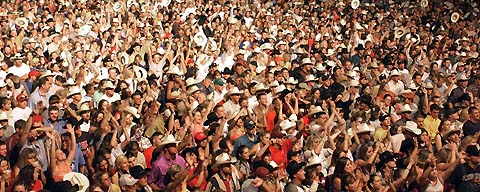Earth
Hurtles Toward 6.5 Billion
by Joanna Glasner on 21 February 2006 in Wired
Magazine
The planet's population is projected to reach 6.5 billion at 7:16
p.m. EST Saturday, according to the U.S. Census Bureau and its World
Population Clock.
Thomas Malthus, the 18th-century thinker who famously predicted
the human population would outrun its food supply, would be astounded.
Back in 1798, when Malthus penned his classic An Essay on the Principle
of Population, barely a billion Homo sapiens roamed the planet.
Today, Earth's population teeters on the brink of a new milestone:
6.5 billion living, breathing humans.
"Malthus would be astonished not only at the numbers of people,
but at the real prosperity of about a fifth of them and the average
prosperity of most of them," said demographer Joel Cohen, a
professor of populations at Rockefeller and Columbia universities.
"He wouldn't be surprised at the abject poverty of the lowest
quarter or third."
The clock, which operates continuously, estimates that each second
4.1 people are born and 1.8 people die. The clock figures are estimates,
subject to error, given the difficulties of maintaining an accurate
global population count.
However, the key concept -- that population levels are growing,
but at a slower rate than in the past few decades -- reflects the
consensus view of demographers. The current growth of world population,
estimated by Cohen at 1.1 percent a year, has slowed significantly
from its peak of 2.1 percent annual growth between 1965 and 1970.
"That's a phenomenal decline," said Cohen, who probed
the question of whether population growth is sustainable in his
book, How Many People Can Earth Support?. (The short answer: It
depends.)
Today, a large portion of the world's population lives in nations
that are at sub-replacement fertility, meaning the average woman
has fewer than two children in her lifetime. Countries in this camp
include former members of the Soviet Union, Japan and most of Europe.
Demographers attribute the slowing rate of global population growth
in part to more-widespread availability of birth control and to
people in developed nations choosing to have fewer children. But
low-birthrate countries are counterbalanced by nations like Yemen,
where the average woman has seven children in her lifetime.
The highest population growth rates emanate disproportionately from
the poorest regions of Africa, the Middle East and the Indian subcontinent.
U.S. population is also growing at a steady clip, augmented by high
numbers of immigrants. It is projected to hit 300 million later
this year. Earth's population is expected to reach 7 billion in
2012, according to the Census Bureau.
Carl Haub, a demographer with the Population Reference Bureau, sees
urbanization contributing to slowing growth, because urban areas
typically have lower birthrates than rural areas. In 1950, less
than 30 percent of people lived in areas defined as urban. Next
year, the United Nations projects that more than half the world's
population will be urban.
As population growth marches forward, debate continues in academia
-- as it has since Malthus' time -- over how many people the Earth
can realistically support.
Certainly individual countries, such as Bangladesh or Rwanda, can
be characterized as overpopulated, said Haub. But in other places,
such as India, it's harder to determine the extent to which overpopulation
-- rather than other social and economic factors -- contributes
to poverty.
Some turn to mathematical models for estimating maximum sustainable
population levels.
One metric modeled on the Census Bureau's population clock compares
world population to the finite supply of arable land.
For his part, Cohen estimates that if we want to support individuals
indefinitely -- allotting each person 3,500 calories per day from
wheat and 247,000 gallons per year of fresh water -- the
planet has room for only about 5 billion people.
But such formulas are subject to tinkering. Changes in agricultural
practices, more efficient water-desalination technologies and a
host of other factors can increase the number of people the planet
can support. Shifts in behavior -- such as acceptance of new food
sources that are cheap to produce -- can have a similar effect,
noted Cohen.
"What most of this commentary neglects is the role of culture
in defining wheat as food but not, let's say, cultured single-cell
algae," he said. |
